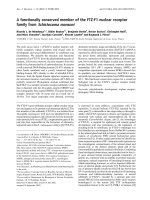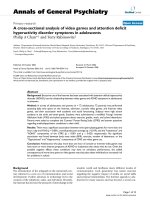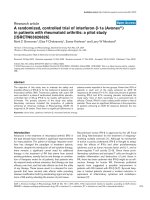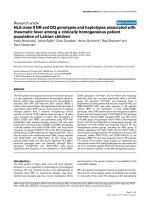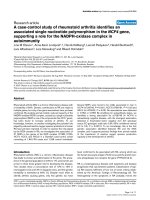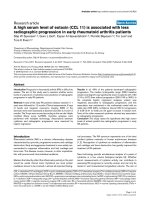Báo cáo y học: " A high serum level of eotaxin (CCL 11) is associated with less radiographic progression in early rheumatoid arthritis patients" doc
Bạn đang xem bản rút gọn của tài liệu. Xem và tải ngay bản đầy đủ của tài liệu tại đây (97.7 KB, 4 trang )
Open Access
Available online />Page 1 of 4
(page number not for citation purposes)
Vol 10 No 2
Research article
A high serum level of eotaxin (CCL 11) is associated with less
radiographic progression in early rheumatoid arthritis patients
Silje W Syversen
1,2
, Guro L Goll
1
, Espen A Haavardsholm
1,2
, Pernille Bøyesen
1,2
, Tor Lea
3
and
Tore K Kvien
1,2
1
Department of Rheumatology, Diakonhjemmet Hospital, Oslo, Norway
2
Faculty of Medicine, University of Oslo, Oslo, Norway
3
Institute of Chemistry, Biotechnology and Food Science, Norwegian University of Life Sciences, Ås, Norway
Corresponding author: Silje W Syversen,
Received: 21 Nov 2007 Revisions requested: 4 Jan 2007 Revisions received: 11 Feb 2008 Accepted: 2 Mar 2008 Published: 2 Mar 2008
Arthritis Research & Therapy 2008, 10:R28 (doi:10.1186/ar2381)
This article is online at: />© 2008 Syversen et al.; licensee BioMed Central Ltd.
This is an open access article distributed under the terms of the Creative Commons Attribution License ( />),
which permits unrestricted use, distribution, and reproduction in any medium, provided the original work is properly cited.
Abstract
Introduction Prognosis in rheumatoid arthritis (RA) is difficult to
assess. The aim of this study was to examine whether serum
levels of a spectrum of cytokines were predictive of radiographic
progression in early RA patients.
Methods A total of 82 early RA patients (disease duration < 1
year) were followed for 12 months. Clinical assessments, X-rays
of hands and magnetic resonance imaging (MRI) of the
dominant wrist were assessed at baseline and after 3, 6 and 12
months. The X-rays were scored according to the van der Heijde
modified Sharp score (vdHSS). Cytokine analyses were
performed with multiplex technology. Associations between
cytokines and radiographic progression were examined by
logistic regression.
Results In all, 49% of the patients developed radiographic
progression. The median (interquartile range (IQR)) baseline
eotaxin level (pg/ml) was significantly lower in patients with (193
(119 to 247)) than without progression (265 (166 to 360)). In
the univariate logistic regression analyses, eotaxin was
negatively associated to radiographic progression, and this
association was maintained in the multivariate model with an
odds ratio (OR) (95% confidence interval (CI)) for progression
of 0.58 (0.41 to 0.82) per 50 pg/ml increase in eotaxin level.
None of the other measured cytokines showed any association
to radiographic progression.
Conclusion This study raises the hypothesis that high serum
levels of eotaxin predict less radiographic progression in early
RA patients.
Introduction
Rheumatoid arthritis (RA) is a chronic inflammatory disease
characterized by synovitis, progressive erosions and cartilage
destruction. Early and aggressive treatment is now widely rec-
ommended to suppress inflammation and limit cartilage and
bone loss. The disease course, however, is often unpredicta-
ble, with pronounced intra-individual variations.
Markers that directly reflect the inflammatory activity in the joint
would be useful clinical tools. Cytokines are local protein
mediators known to be involved in almost all important biolog-
ical processes. The RA synovium represents one of the best
studied cytokine networks of human autoimmune diseases
[1,2]. Recognition of cytokines as mediators of inflammation
and cartilage and bone destruction has greatly improved the
treatment of RA patients.
New technology permits simultaneous analysis of a panel of
cytokines in a low volume biological sample [3]. Whether
serum measurements of cytokine activity can contribute in
assessing RA prognosis is currently unclear, and can only be
tested in well characterized longitudinal cohorts. The aim of
CCL = chemokine C-C motif ligand; CCP = cyclic citrullinated peptide; CCR = C-C chemokine receptor; CI = confidence interval; CRP = C-reactive
protein; DAS28 = 28-joint Disease Activity Score; DMARD = disease-modifying antirheumatic drug; ELISA = enzyme-linked immunosorbent assay;
ESR = erythrocyte sedimentation rate; GM-CSF = granulocyte-macrophage colony-stimulating factor; hsCRP = high sensitivity CRP; IFN = interferon;
IL = interleukin; IQR = interquartile range; JIA = juvenile idiopathic arthritis; MIG = monokine induced by gamma interferon; MIP = macrophage inflam-
matory protein; MRI = magnetic resonance imaging; OR = odds ratio; RA = rheumatoid arthritis; RAMRIS = RA magnetic resonance imaging score;
RANTES = regulated on activation normal T-cell expressed and secreted; RF = rheumatoid factor; ROC = receiver operating characteristic; TNFα =
tumor necrosis factor α; vdHSS = van der Heijde modified Sharp score.
Arthritis Research & Therapy Vol 10 No 2 Syversen et al.
Page 2 of 4
(page number not for citation purposes)
this study was to explore the associations between the serum
levels of a broad spectrum of T- and B-cell derived cytokines,
growth factors and chemokines and 1-year radiographic pro-
gression in early RA patients.
Materials and methods
Patients
A total of 84 consecutively enrolled RA patients with disease
duration of less than 1 year were followed for 12 months [4].
Clinical examination, X-rays of hands, magenetic resonance
imaging (MRI) of the dominant wrist and laboratory analyses
were assessed at baseline and after 3, 6 and 12 months. The
patients received treatment according to clinical practice. Dis-
ease-modifying antirheumatic drugs (DMARDs) were used by
77.4% of the included patients at baseline. During the study,
DMARDs were used by 91.8% of the patients and anti-tumor
necrosis factor (TNF)α drugs by two patients (2.6%). The
regional ethics committee evaluated the study, and all
included patients gave informed consent.
Laboratory analyses
Serum samples were stored at -70°C. Erythrocyte sedimenta-
tion rate (ESR) was measured by an in-house Westergren
method, antibodies to cyclic citrullinated peptide (anti-CCP)
were analyzed by a second generation ELISA kit (INOVA Diag-
nostics Inc, San Diego, USA), IgM rheumatoid factors by an in-
house ELISA and high sensitivity C-reactive protein (hsCRP)
was measured by nephelometry (Dade Behring, USA).
Cytokine analyses were performed with multiplex fluoroimmu-
noassay technology (Biosource Cytokine 25-plex from
Luminex Corporation, Austin, USA). The multiplex assay sys-
tem has been validated against the traditional ELISA sandwich
assay for cytokines and found to perform very reliably [5].
Measured cytokines were: eotaxin, TNFα, interferon (IFN)γ,
IFNα, macrophage inflammatory protein (MIP)1-α, IP10
Human interferon-gamma (IFN-gamma)-inducible protein 10,
monokine induced by gamma interferon (MIG), monocyte
chemotactic protein (MCP)1, granulocyte-macrophage col-
ony-stimulating factor (GM-CSF), MIP1β, IL1β, IL1-ra, IL2,
IL2R, IL4, IL5, IL6, IL7, IL8, IL10, IL12, IL13, IL15, IL17 and
RANTES (regulated on activation normal T-cell expressed and
secreted).
Acquisition and assessment of MRIs and conventional
radiographs
X-rays of the hands were scored according to the van der Hei-
jde modified Sharp score (vdHSS) by a trained observer (PB).
In each hand, 16 joint areas were scored for erosions (score
range for each area 0 to 5) and 15 areas were scored for joint
space narrowing (range of score from 0 to 4 for each joint
area), giving a possible maximum score of 280 units. MRI of
the dominant wrist was performed using a Sigma 1.5 Tesla
MRI scanner (General Electric, Milwaukee, WI, USA). The MRI
sequences and scoring in this study have previously been
described in detail [6]. Images were scored according to the
semi-quantitative RA magnetic resonance imaging score
(RAMRIS) [7] by a trained observer (EAH).
Statistical methods
Statistical analyses were performed using SPSS 14 (SPSS
Inc, Chicago, IL, USA). Data were presented by median (inter-
quartile range (IQR)) because of skewed data. Correlations
were assessed by Spearman's test of rank correlation. Com-
parisons between groups were examined by the Mann-Whit-
ney U test. Uni- and multivariate logistic and linear regression
analyses were performed to examine the predictive potential of
the cytokines. Clinically important covariates were included in
the multivariate analyses if univariate analyses revealed a p
value < 0.25. All tests were two-sided and p values below
0.05 were considered to be statistically significant. Correction
for multiple testing was not performed.
Results
The baseline characteristics of the cohort with averages given
as median (IQR) were as follows: age 58 (47 to 67) years, dis-
ease duration 107 (77 to 188) days and 28-joint Disease
Activity Score (DAS28) 4.2 (3.0 to 5.1). A total of 77.4% of
patients were female, 44% were IgM rheumatoid factor (RF)
positive and 55% anti-CCP positive. Associations between
baseline serum level and radiographic progression were exam-
ined for all the 25 cytokines. We will only focus on the eotaxin
results in this paper as none of the other cytokines showed any
association to radiographic progression.
Median (IQR) baseline eotaxin level (pg/ml) was 214.0 (137.2
to 323.3), mean (SD) level 242 (163) (pg/ml). Suggested nor-
mal values from the manufacturer were 72 to 248 pg/ml. There
was no correlation between baseline eotaxin level and meas-
ures of disease activity measured by DAS28 and acute phase
reactants. A correlation coefficient of 0.27 (p 0.02) was found
between eotaxin and anti-CCP.
In all, 49% of the patients developed radiographic progression
(increase in total vdHSS score ≥ 1 unit) during follow-up.
Median (IQR) baseline eotaxin level (pg/ml) was significantly
(p = 0.007) lower in patients with (193 (119 to 247)) than
without radiographic progression (265 (166 to 360)). The
baseline eotaxin level was moderately and significantly nega-
tive correlated (r = -0.35) to a change in vdHSS during follow-
up. In the univariate logistic regression analyses eotaxin was
significantly (p < 0.05) associated to radiographic non-pro-
gression, with an odds ratio for progression of 0.70 per 50 pg/
ml increase in eotaxin. We controlled for other known predic-
tors of radiographic progression (ESR, CRP, baseline vdHSS,
anti-CCP, IgM RF) and age and gender in a multivariate logis-
tic regression model. We also included RAMRIS bone marrow
edema score > 2 in the model based on previous findings in
the same cohort of patients [4]. In the final logistic regression
model, the adjusted odds ratio (OR) (95% confidence interval
(CI)) for progression was 0.58 (0.41 to 0.82) per 50 pg/ml
Available online />Page 3 of 4
(page number not for citation purposes)
increase in eotaxin level (Table 1). Hence, in this study, an
increase in the baseline eotaxin level of 50 pg/ml corre-
sponded to a 42% decrease in the odds of radiographic pro-
gression. The range of eotaxin is 50 to 500 pg/ml. Bone
marrow edema on MRI, male gender and disease activity at
baseline also independently predicted radiographic progres-
sion. The accuracy of the model to predict radiographic pro-
gression was 71%. In the regression analyses, eotaxin showed
linearity without any obvious cut-off value for discrimination
between progression and non-progression. In a receiver oper-
ating characteristic (ROC) analysis the value of 214 (corre-
sponding to the median value) gave the highest value for the
combination of sensitivity (0.6) and specificity (0.6). The area
under the curve was 0.69. When eotaxin was entered into the
logistic regression as a dichotomized variable according to the
ROC analysis, the OR for progression with a low eotaxine was
3.6 (CI 1.1 to 11.9; Table 1). The accuracy of this model is
64%.
To gain statistical power, a multivariate linear regression model
was also applied and gave similar results (data not shown).
Discussion
RA patients express increased serum levels of several
cytokines, but the evidence for a clinical relevance of such
measurements in the assessment of prognosis is limited. In
this 1-year prospective study of 84 early RA patients, we found
that a high serum level of eotaxin in the early disease course
was associated with less subsequent radiographic progres-
sion. The association between eotaxin level at baseline and
radiographic progression remained strong when adjusting for
other known predictors of joint destruction. Serum levels of the
other tested cytokines in this study were not associated with
radiographic progression.
Chemokines are suggested to be important in RA pathology
and elevated levels have been measured in the synovium and
serum of RA patients [8-10]. Hueber et al. found elevated
serum levels of chemokines to be the most evident difference
between early RA patients and controls [10]. Eotaxin (chem-
okine C-C motif ligand 11 (CCL11)), a member of the CC
chemokine family, recruits eosinophils to sites of inflammation,
particularly in allergic diseases and asthma [11]. It is produced
by lymphocytes, eosinophils and monocytes/macrophages,
and interacts with C-C chemokine receptor 3 (CCR3) [11].
This receptor is expressed by T-lymphocytes, eosinophils,
basophils, dendritic cells, and a recent study has also sug-
gested expression of CCR3 on osteoclasts [11-13].
A Korean study has suggested a link between eotaxin gene
polymorphisms and RA [14]. Two recent studies have shown
increased eotaxin in the plasma of juvenile idiopathic arthritis
(JIA) and serum of RA patients compared to normal controls
[10,15], and it has been suggested that eotaxin may be one of
several cytokines denoting low activity in JIA joint disease [15].
The possible expression of the CCR3 receptor on osteoclasts
and the suggested involvement in osteoporosis might indicate
a role in bone resorption [12,13].
The role of eotaxin in RA patients and thus the pathophysiolog-
ical impact of the negative association to radiographic pro-
gression, however, are currently unclear. One may speculate
whether high eotaxin levels denote a more T-helper (Th) 2-type
response in individual RA patients, possibly protecting against
joint damage.
Our study has some limitations. Patients were treated accord-
ing to clinical judgment before inclusion and during the study.
The 1-year follow-up could be insufficient to reveal an associ-
ation between progression and serum levels of any of the other
tested biomarkers. We cannot exclude that the association
between eotaxin levels and radiographic progression is an
arbitrary finding due to multiple testing or an unknown con-
founder. The p values, however, were far below 0.01, despite
the relatively small number of patients included.
One can question whether measurements of cytokines in
serum reflect the cytokine levels in the joint; however serum
Table 1
Predictors of 12 months radiographic progression
Eotaxine as a continous variable Eotaxine as a dichotomized variable
OR (95% CI) p Value OR (95% CI) p Value
Baseline variable:
Eotaxin (per 50 pg/ml) 0.6 (0.4–0.8) < 0.01
Eotaxine (low < 214 vs high > 214) 3.6 (1.1–11.9) 0.04
DAS28 1.6 (1.0–2.4) 0.05
RAMRIS bone marrow edema score > 2 3.4 (1.0–11.2) 0.05 3.7 (1.2–11.7) 0.03
Male 6.9 (1.6–30.5) 0.01 3.5 (0.9–13.6) 0.06
DAS28, 28-joint Disease Activity Score; OR, odds ratio; RAMRIS, rheumatoid arthritis magnetic resonance imaging score.
Arthritis Research & Therapy Vol 10 No 2 Syversen et al.
Page 4 of 4
(page number not for citation purposes)
measurements of cytokines might regardless be clinically use-
ful if associated to important patient outcome. To our knowl-
edge this is the first prospective study to explore the
associations between radiographic progression and a broad
spectrum of cytokines.
Conclusion
This study raises the hypothesis that low serum levels of
eotaxin predict radiographic progression in early RA patients.
It is, however, critical that the relationship is confirmed in an
independent cohort of patients, preferably with longer follow-
up time.
Authors' contributions
SWS participated in study design and coordination, analyzed
and interpreted the data and drafted the manuscript, GLG par-
ticipated in study design and coordination, assisted in drafting
the manuscript, and EAH and PB participated in study design
and coordination, read and interpreted the MRIs and X-rays.
TL analyzed the cytokines, TKK designed the study, assisted
in interpretation of statistical analyses and drafting of the man-
uscript. All authors read and approved the final manuscript.
Competing interests
The authors declare that they have no competing interests.
Acknowledgements
We thank research nurse Margareth Sveinsson for collecting clinical
data, research coordinator Tone Omreng for organizing the data collec-
tion, Halvor Gilboe for practical assistance with CRFs, Marianne Ytrelid
for technical assistance, and Dr Inge Olsen for statistical advice and Drs
Annelies Boonen and Desirée van der Heijde for advice and assistance
with radiographic scoring methodology. This study was supported in
part by grants from the Eastern Norway Regional Health Authority, The
Research Council of Norway, The Norwegian Rheumatism Association,
The Norwegian Women Public Health Association, the Grethe Harbitz
Legacy and the Marie and Else Mustad Legacy.
References
1. Andreakos ET, Foxwell BM, Brennan FM, Maini RN, Feldmann M:
Cytokines and anti-cytokine biologicals in autoimmunity:
present and future. Cytokine Growth Factor Rev 2002,
13:299-313.
2. Feldmann M, Brennan FM, Maini RN: Role of cytokines in rheu-
matoid arthritis. Ann Rev Immunol 1996, 14:397-440.
3. Carson RT, Vignali DA: Simultaneous quantitation of 15
cytokines using a multiplexed flow cytometric assay. J Immu-
nol Methods 1999, 227:41-52.
4. Haavardsholm EA, Boyesen P, Ostergaard M, Schildvold A, Kvien
TK: MRI findings in 84 early rheumatoid arthritis patients :
bone marrow edema predicts erosive progression. Ann
Rheum Dis 2007. doi: 10.1136/ard.2007.071977.
5. Dupont NC, Wang K, Wadhwa PD, Culhane JF, Nelson EL: Vali-
dation and comparison of luminex multiplex cytokine analysis
kits with ELISA: determinations of a panel of nine cytokines in
clinical sample culture supernatants. J Reprod Immunol 2005,
66:175-191.
6. Haavardsholm EA, Østergaard M, Ejbjerg BJ, Kvan NP, Uhlig TA,
Lilleas FG, Kvein TK: Reliability and sensitivity to change of the
OMERACT rheumatoid arthritis magnetic resonance imaging
score in a multireader, longitudinal setting. Arthritis Rheum
2005, 52:3860-3867.
7. Østergaard M, Peterfy C, Conaghan P, McQueen F, Bird P, Ejbjerg
B, Shnier R, O'Connor P, Klarlund M, Emery P, Genant H, Lassere
M, Edmonds J: OMERACT rheumatoid arthritis magnetic reso-
nance imaging studies. Core set of MRI acquisitions, joint
pathology definitions, and the OMERACT RA-MRI scoring
system. J Rheumatol 2003, 30:1385-1386.
8. Klimiuk PA, Sierakowski S, Latosiewicz R, Skowronski J, Cylwik JP,
Cylwik B, Chwiecko J: Histological patterns of synovitis and
serum chemokines in patients with rheumatoid arthritis. J
Rheumatol 2005, 32:1666-1672.
9. Yao TC, Kuo ML, See LC, Ou LS, Lee WI, Chan CK, Huang JL:
RANTES and monocyte chemoattractant protein 1 as sensitive
markers of disease activity in patients with juvenile rheuma-
toid arthritis: a six-year longitudinal study. Arthritis Rheum
2006, 54:2585-2593.
10. Hueber W, Tomooka BH, Zhao X, Kidd BA, Drijfhout JW, Fries JF,
Van Venrooij WJ, Metzger AL, Genovese MC, Robinson WH: Pro-
teomic analysis of secreted proteins in early rheumatoid
arthritis: anti-citrulline reactivity is associated with upregula-
tion of proinflammatory cytokines. Ann Rheum Dis 2007,
66:712-719.
11. Van Coillie E, Van Damme J, Opdenakker G: The MCP/eotaxin
subfamily of CC chemokines. Cytokine Growth Factor Rev
1999, 10:61-86.
12. Lean JM, Murphy C, Fuller K, Chambers TJ: CCL9/MIP-1gamma
and its receptor CCR1 are the major chemokine ligand/recep-
tor species expressed by osteoclasts. J Cell Biochem 2002,
87:386-393.
13. Liu YZ, Dvornyk V, Lu Y, Shen H, Lappe JM, Recker RR, Deng HW:
A novel pathophysiological mechanism for osteoporosis sug-
gested by an in vivo gene expression study of circulating
monocytes. J Biol Chem 2005, 280:29011-29016.
14. Chae SC, Park YR, Shim SC, Lee IK, Chung HT: Eotaxin-3 gene
polymorphisms are associated with rheumatoid arthritis in a
Korean population. Hum Immunol 2005, 66:314-320.
15. de Jaeger W, Hoppenreijs EP, Wulffraat NM, Wedderburn LR,
Kuis W, Prakken BJ: Blood and synovial fluid cytokine signa-
tures in patients with juvenile idiopathic arthritis: a cross-sec-
tional study. Ann Rheum Dis 2007, 66:589-598.
